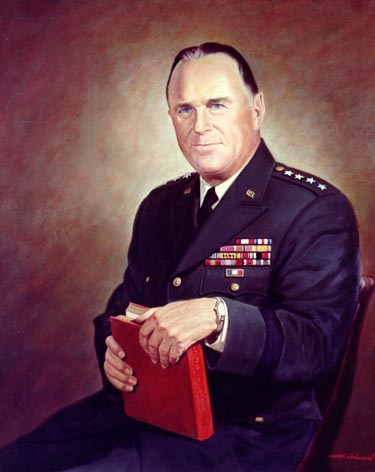
George Henry Decker was born in Catskill, New York, on 16 February 1902; graduated from Lafayette College, Easton, Pennsylvania, with a degree in economics, 1924; was commissioned a second lieutenant, June 1924, and served with the 26th Infantry at Plattsburg Barracks, 19241928; married Helen E. Inman, 1926; served with the 35th Infantry in Hawaii, 19281931; was promoted to first lieutenant, April 1930; graduated from the Infantry School at Fort Benning, 1932, and then served at Fort Benning with the 29th Infantry, 19321935, and at Fort Vancouver with the 7th Infantry 19351936; was promoted to captain, August 1935; graduated from the Command and General Staff School at Fort Leavenworth, 1937; served with the 10th Infantry at Forts Thomas and McClellan and the 9th Infantry at Fort Bragg, 19371940; established and commanded Headquarters Company, I Corps, at Fort Jackson and was assistant supply and logistics officer, 19401941; was promoted to temporary major (January), permanent major (June), and temporary lieutenant colonel (December), 1941; served on the War Department General Staff in the Office of the Assistant Chief of Staff for Supply, 19411942; was promoted to temporary colonel, October 1942; was deputy chief of staff of the Third Army, Fort Sam Houston, 19421944; served in the Southwest Pacific as deputy chief of staff (19431944) and chief of staff (19441946) of the Sixth Army; participated in operations from New Guinea to the Philippines and in the early occupation of Japan; was promoted to temporary ranks of brigadier general, August 1944, and major general, June 1945; served in Washington successively in Army Ground Forces and Army Service Forces headquarters, 1946; was deputy commander and chief of staff of United States Forces, Middle Pacific, Hawaii, 19461948; was promoted to the permanent ranks of lieutenant colonel, June 1947, and colonel, June 1948; commanded the 5th Infantry Division at Fort Jackson, 19481950; served in the Office of the Comptroller of the Army as chief of the Budget Division, 19501952; was promoted to temporary lieutenant general, June 1952; was comptroller of the Army 19521955; was promoted to the permanent ranks of brigadier general, April 1953, and major general, July 1954; commanded VII Corps at Stuttgart, Germany, 19551956; was promoted to temporary general, May 1956; was deputy commander in chief of the United States European Command, France, 19561957; was concurrently commander in chief of the United Nations Command and commander of United States Forces and Eighth Army, Korea, 19571959; was vice chief of staff of the Army, 19591960; was chief of staff of the United States Army, 1 October 196030 September 1962; supervised augmentations to meet a crisis in Berlin, an increase in special warfare forces, initiation of new divisional (ROAD) and forward depot concepts, and expansion of the Army to sixteen divisions; retired from active service, September 1962; died in Washington, D.C., on 6 February 1980.
The Artist
Woodi Ishmael (1914) was born in Lewis County, Kentucky, and entered his profession through the Cleveland (Ohio) Institute of Arts and the Art Students League in New York City. He maintains a studio at Troy State University, Troy, Alabama, where he teaches drawing, painting, and art appreciation. As painter and illustrator, Mr. Ishmael has drawn a weekly syndicated column for Associated Press Newsfeatures, called "The Power of Faith"; served as an official artist for the United States Air Force; sailed as artist-in-residence on major ocean liners to deliver art lectures and demonstrations; and officiated as the only courtroom artist at the Jack Ruby trial. In addition to painting General George Deckers portrait, he has done those of several Air Force chiefs of staff.
George Henry Decker
By Woodi Ishmael
Oil on canvas, 36" x 30", 1972
[134]

[135]